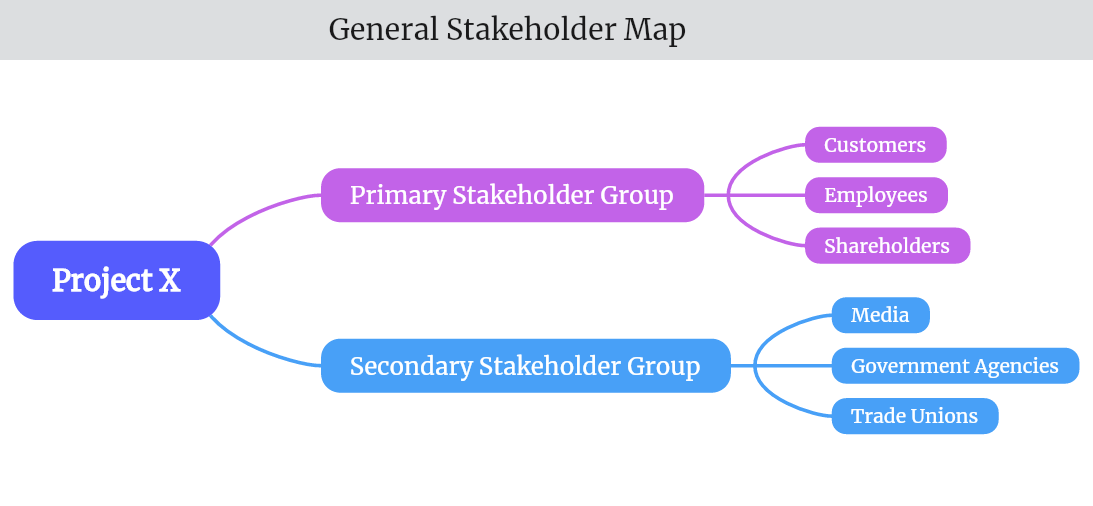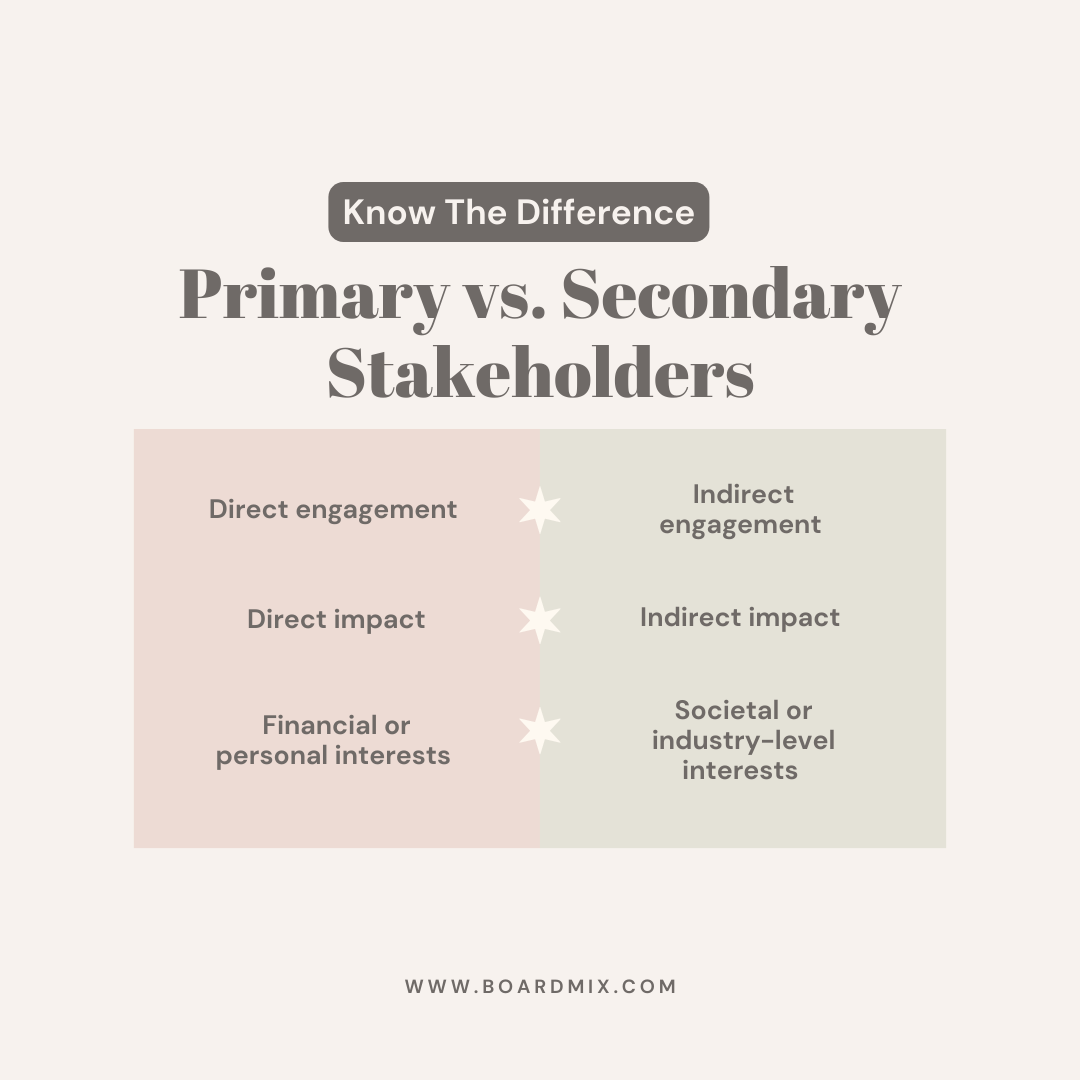In the dynamic world of business, every organization has an array of individuals or entities that have a vested interest in its success, sustainability, and growth. These individuals or entities are often referred to as stakeholders. Understanding who your stakeholders are, and more importantly, knowing the difference between primary and secondary stakeholders, is essential for effective stakeholder management and overall business success.
What is a stakeholder?
A stakeholder is an individual, group, or entity that has an interest or concern in an organization. They are directly or indirectly impacted by the organization's actions, objectives, and policies. Stakeholders may also have the ability to influence the company's operations, decision-making processes, financial resources, or general business trajectory.
Stakeholders can be divided into two main categories: primary stakeholders and secondary stakeholders. Both play crucial roles, but their level of influence and interest differs.
What are primary stakeholders?
Primary stakeholders are individuals or groups that are directly affected, either positively or negatively, by an organization’s actions. They have a direct relationship with the company and often hold significant power and influence over the organization’s decisions and operations.
Primary stakeholders typically have a more substantial stake in the organization's success because their welfare is closely tied to the company’s performance. This can be seen in case studies where primary stakeholders have significantly impacted business outcomes. For instance, employees deciding to strike can disrupt production processes, and disgruntled customers leaving negative reviews can affect brand reputation.

Some examples of primary stakeholders
Primary stakeholders typically have a direct and immediate relationship with the business. They often have a significant financial or personal stake in the company, and their actions can directly impact the company's success. Here are some common examples of primary stakeholders:
Customers
Customers are arguably the most crucial stakeholders for any business, as they determine the demand for its products or services. They are the source of a company's revenue and thus, play a vital role in its financial sustainability. In addition, customer feedback can directly influence a company’s reputation, product offerings, and service quality.
A satisfied customer base can boost a company’s reputation through word-of-mouth referrals and positive online reviews. On the other hand, dissatisfied customers can damage a brand's image and cause substantial harm to a company's profitability and market standing.
Employees
Employees are also essential primary stakeholders as they are directly involved in a business's operational processes. They produce goods or provide services, manage operations, contribute to organizational culture, and drive innovation.
Employees' skills, morale, productivity, and loyalty can significantly affect a company's efficiency, service quality, and overall performance. Therefore, maintaining positive employee relations through fair compensation, good working conditions, and development opportunities is crucial to achieve business goals.
Shareholders
Shareholders, who could be individuals or institutions, are vital primary stakeholders as they provide the necessary capital to fund an organization's operations, expansion initiatives, or investments. In return for their investment, shareholders expect dividends or increased share value.
Shareholders often exert influence over strategic business decisions through their voting rights at annual general meetings. Thus, meeting shareholders' expectations is vital for gaining their support for key strategic decisions and ensuring financial sustainability. Misalignment between shareholders’ expectations and business outcomes could lead to significant share price fluctuations and instability.
What are secondary stakeholders?
On the other hand, secondary stakeholders, also known as indirect stakeholders, have a less immediate, but still important connection with the organization. They do not engage directly with the company but are affected by its actions in some way or another.
While secondary stakeholders may not have a direct impact on an organization's operations, their influence should not be underestimated. Their impact on a business may not be as immediate or direct as that of primary stakeholders, but they can significantly influence public perception and regulatory environments.
Some examples of secondary stakeholders
Secondary stakeholders, although they may not engage directly with a company, can still have a substantial impact on its reputation, operations, and regulatory environment. Here are some key examples of secondary stakeholders:
Media
The role of media as a stakeholder is particularly powerful in the modern era where news spreads rapidly across social platforms and networks. Media outlets shape public opinion about a company's products, services, ethics, and more. Positive media coverage can boost a company's reputation and sales while negative coverage can lead to loss of customer trust and reduced market share. Media also provides a platform for other stakeholders, such as activists or critics, to voice their views about the company.
Government Agencies
Government agencies wield influence through the regulatory environment within which businesses operate. They establish and enforce laws and regulations that a company must follow to legally conduct its business. These can cover areas such as health and safety standards, employment practices, environmental regulations, tax policies, and more. Non-compliance can result in penalties, legal actions, and damage to the company's reputation. On the other hand, government support in the form of subsidies or tax breaks can be advantageous for businesses.
Trade Unions
Trade unions are organizations that represent the collective interests of workers in specific industries or occupations. While they are not part of the company itself, they can exert significant influence over it through collective bargaining agreements, strikes, or other industrial action.
Trade unions aim to negotiate better working conditions, higher wages, and other benefits for their members. They can also influence public opinion about a company's labor practices. Consequently, maintaining a good relationship with relevant trade unions can contribute to smoother business operations and better employee morale.
What are the main differences between primary stakeholders and secondary stakeholders?

Primary and secondary stakeholders both play significant roles in influencing a company's operations and success. However, their interests, level of influence, and relationship with the company differ in several ways. Here are the main differences:
Level of Engagement
Primary stakeholders typically have a direct engagement with the organization. They have a vested interest in the company's success because their welfare is directly tied to the business. Examples include customers who purchase the company's products or services, employees who work for the company, and shareholders who invest in it.
In contrast, secondary stakeholders have an indirect engagement with the company. They may not interact directly with the business but are affected by its actions in some way or another. This group includes entities like media outlets that report on the company, government agencies that regulate it, and trade unions that represent industry workers.
Impact on Business Operations
Primary stakeholders have a direct impact on business operations and strategic decisions. The actions of employees can affect productivity and quality, customer feedback can shape product offerings, and shareholder decisions can affect financial resources.
Secondary stakeholders, on the other hand, have an indirect impact on business operations. They affect the company’s external environment by shaping public opinion, setting regulations, or influencing workforce conditions. Their actions can create opportunities or pose threats to the company, thereby indirectly influencing its strategy and operations.
Interests and Priorities
Primary stakeholders usually have financial or personal interests in the company’s performance. For example, customers want high-quality products at competitive prices, employees seek job security and fair compensation, and shareholders want a return on their investment.
Secondary stakeholders tend to have societal or industry-level interests in the company. Media outlets aim to provide news-worthy stories, government agencies seek regulatory compliance for societal benefit, and trade unions want fair treatment of workers in the industry.
Tips for Managing Both Types of Stakeholders
Successfully managing both types of stakeholders requires effective communication and strategic planning. Utilizing online tools such as Boardmix, an online whiteboard and diagram maker, can help in creating visual roadmaps for stakeholder engagement and management.
Understanding your stakeholders' needs, interests, and potential impact on your organization are all critical steps to forming robust stakeholder management strategies. Companies that master the art of managing both primary and secondary stakeholders will undoubtedly be in a better position to navigate the complex world of business successfully.













